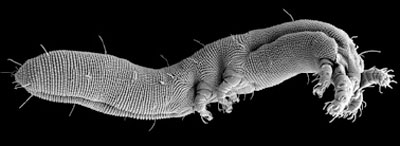New mite species (continued from last month)
New mite species
Samuel Bolton and collaborators at Ohio State University recently described a new species and genus of mite that appears to have come up with an ingenious solution to this problem.
When they examined this mite using low-temperature scanning electron microscopy (LT-SEM), they discovered that it has a tiny pouch that acts as a type of holder for microbes.
If the mite could somehow place a microorganism inside the pouch—which is about the right size to contain a yeast or bacterium—the chelicerae could then slot into the pouch so that the microorganism would break up, allowing the fluid contents to be drawn up underneath the labrum and into the mouth.
In this way these mites could be sure to ingest all of the fluid contents of a microorganism after they have ruptured it.
The really amazing element is the size of these mites. From 0.1 – 0.5mm, small enough to actually capture and hold a single bacteria or yeast.
Single cell bacteria, and yeasts (which are single cell organisms), may be 3–4 micron in size. A human hair is around 50 micron in size.
Beneficial bugs eaten by macromites?
When new beneficial bugs are introduced to the soil, do they end up on the menu for macromites and others, like soil insects? Many may well do.
A real misunderstanding (perhaps mis-information) is that adding specialised bugs to the soil will automatically make the soil healthier—it won’t.
The bugs may flourish for a while, but then die back to normal levels as soil organisms come back into balance.
With the abundance of soil microorganisms having an effect on each other through the food web, our understanding of the whole complex environment below our feet is quite minuscule.
For more information, see Tree Fruit September 2015




















